Heading out the door? Read this article on the new Outside+ app available now on iOS devices for members! Download the app.
Americans are no strangers to angst—in fact, more than 40 million of us have been diagnosed with anxiety disorders. Although not everyone experiences an intense level of stress and anxiety, we’re not immune to the symptoms. For instance, in a 2024 survey by the American Psychological Association, 43 percent of adults reported they felt more anxious than the year prior.
Stress and anxiety aren’t necessarily bad things, explains Nancy Molitor, PhD, an Illinois-based psychologist and an assistant professor of clinical psychiatry and behavioral science at Northwestern University’s Feinberg School of Medicine. But when they persist, they can contribute to or worsen physical and mental health issues. They can lead to increased heart rate and blood pressure, muscle tension, and depression, she says. Over longer periods of time, stress and anxiety have been linked with inflammation and other health issues.
Fortunately, there’s an arsenal of research-backed tools that can equip you to better handle mental tension—including yoga for stress relief.
Defining Stress and Anxiety
Though they have some distinct differences, both stress and anxiety represent varying degrees of nervous system imbalance, explains Robin Gilmartin, a licensed clinical social worker who specializes in anxiety and post-traumatic stress disorder.
Stress is defined as a reaction to a life event that disturbs a person’s physical and mental equilibrium. Someone who is stressed out might become edgy or overwhelmed by sitting in traffic or thinking about their workload, whereas anxiety is not necessarily event driven, says Molitor. “You might wake up and just feel ‘off’ or uncertain,” she says.
The catalyst for both stress and anxiety is a primal, hardwired neurological response to a potential threat. When something presents a challenge—whether an event, memory, or a general sense of shouldering the weight of the world—your sympathetic nervous system, or the nerves that control your “fight or flight” response, send signals to your brain to flood your body with stress hormones including adrenaline and cortisol. These shorten your breath, fire your muscles, sharpen your focus, and jolt you into action.
That’s normal, and helpful if you, say, happen to come across a mountain lion on a remote trail or are a sprinter at the starting blocks. But when you remain in a heightened stress state—for example, when you have to take care of a sick loved one for months or years or continue to carry the burden of being understaffed at work—the potential health consequences start to add up.
So how do you regain balance?
Benefits of Yoga for Stress Relief
A growing body of research shows that practicing mindfulness and breathing more slowly can tame sympathetic activity and balance the nervous system. “When you take a deep breath, you tell the body to relax,” explains Erin Byron, co-author of Yoga Therapy for Stress and Anxiety and an Ontario, Canada-based psychotherapist and yoga and meditation teacher.
Slow, mindful breaths activate the parasympathetic nervous system—the sympathetic nervous system’s counterpart. When the breath slows, the parasympathetic nervous system in turn slows the heart and sends a relaxing message to the nerves, inspiring a “rest and digest” response, explains Byron. Several yogic tools encourage us to slow our breathing and stay present, including gentle movement; meditation; certain types of breathwork (pranayama); and rest in the form of Corpse Pose (Savasana) and yoga nidra.
Yoga Sequence to Soothe Stress & Anxiety
Practicing these poses—along with a steady Ujjayi breath—slowly and audibly breathing in and out through the nose—can help you activate the parasympathetic nervous system, and in turn, a greater sense of calm. The breath and physical postures also help you stay in the present moment and help counter the anxiety that can arise when thinking about the past and future, explains Suzanne Manafort, the founder of Mindful Yoga Therapy.
Consider taking a moment to think about one thing you are grateful for and use that as an intention for your practice. Bring your focus back to that if you find yourself distracted.
Practice this as many times as needed during the week and notice any shifts in the way you react to stress.
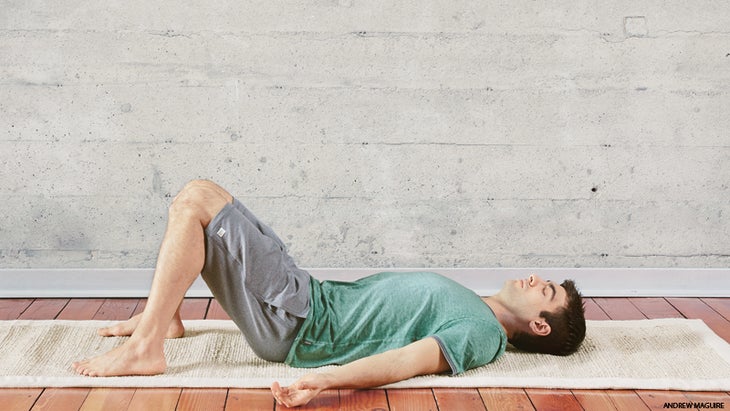
1. Constructive Rest
Lie on your back with your knees bent and your feet on the floor hip-distance apart. Allow your knees to touch. Close your eyes or soften your gaze. Simply observe your breath. It may feel deep and rich or it may feel shallow and light—there is no right or wrong. Allow the breath to wash through you. If it feels appropriate, focus on one specific area that may resist release. As you bring your focus to this area, treat your awareness as if it were a sponge: Every time you inhale, the sponge brings in fresh, new oxygen that washes through you, and when you exhale it releases anything unneeded or unwanted. Take as much time here as needed.
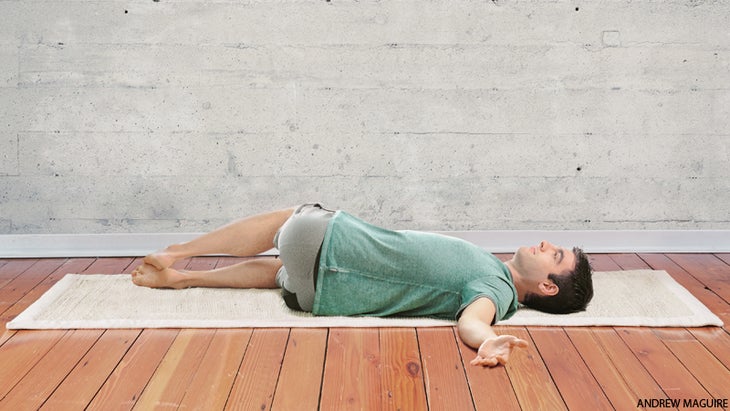
2. Supine Twist
Draw your knees toward your chest, place your right hand on your left knee, and reach your left arm straight out to the left. As you exhale, lower your knees to the right and let them rest on the floor or tuck a pillow beneath them. Take 3-5 breaths here. Inhale and draw your knees back to center. Repeat on the other side. Inhale and bring your knees back to center; draw them toward your chest one more time. Exhale and release your feet to the floor. When you’re ready, roll to one side, rise to a seated position, then come to your hands and knees.
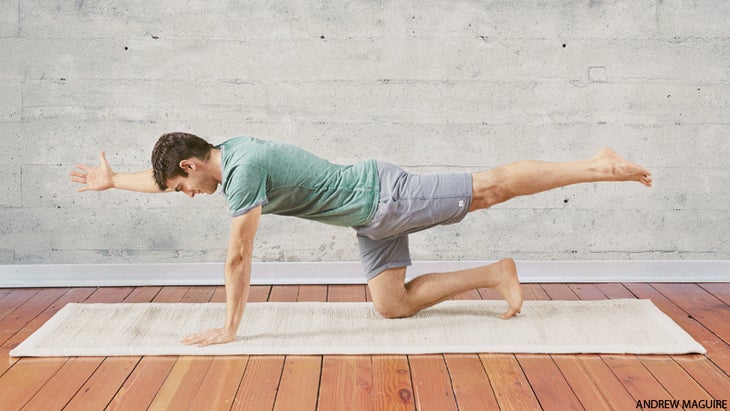
3. Hands and Knees Balance
Place your hands slightly in front of your shoulders and bring your knees directly under your hips. Press your hands into the floor. Let this keep you grounded and present. Softly bend your elbows. As you continue pressing, noticing if you can feel the rebound of that connection all the way through your body. Draw your navel toward your spine for support.
Inhale and reach your right arm toward the front wall and your left leg toward the wall behind you. Press your opposite hand and foot into the floor to help keep you steady. Remain here for 5 breaths, then exhale as you draw your lifted arm and leg back to the floor. Repeat on the other side.
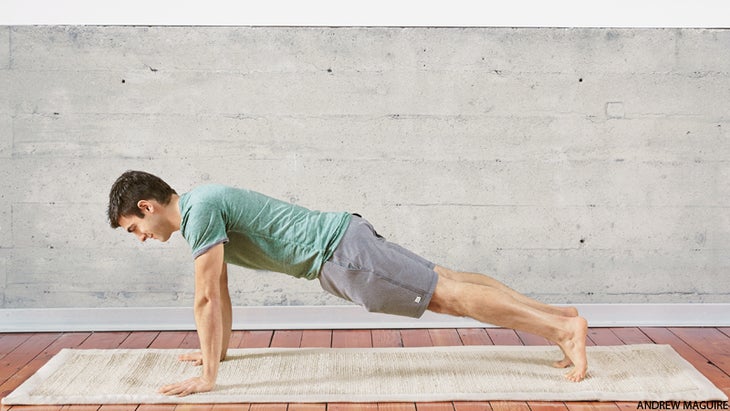
4. Plank
From hands and knees, step your feet back into Plank. Your hands should be directly under your shoulders and your body should form one long, even line. Feel your hands pressing into the floor and sense the connection from your feet to your head. Draw your navel toward your spine. Keep your chest broad rather than rounding your shoulders. Be mindful not to let your hips sink. Take 5 breaths here, focusing on your Ujjayi breath. Then lower your knees back to the floor.
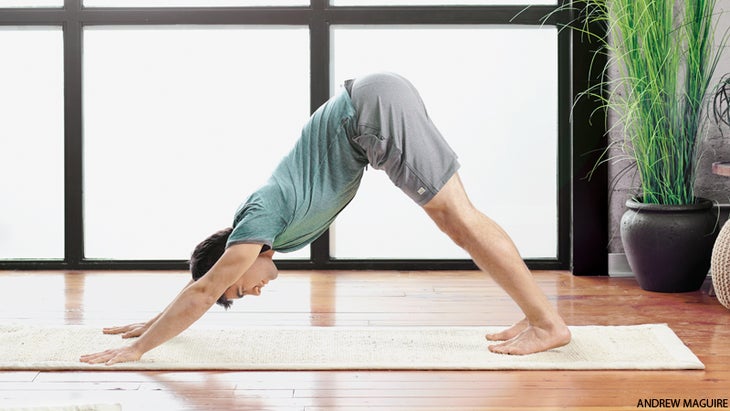
5. Downward-Facing Dog Pose (Adho Mukha Svanasana)
From your hands and knees, press your hands into the floor, tuck your toes, and push your hips up and back into Downward-Facing Dog. See if you can draw your awareness from your hands all the way to your sitting bones. Draw your navel toward your spine. If you have tight hamstrings, keep your knees bent. Take 5-10 breaths here, grounding your hands into the floor and reaching your heels toward the floor. To come out of it, walk your hands to your feet or your feet to your hands. Inhale and rise to standing.
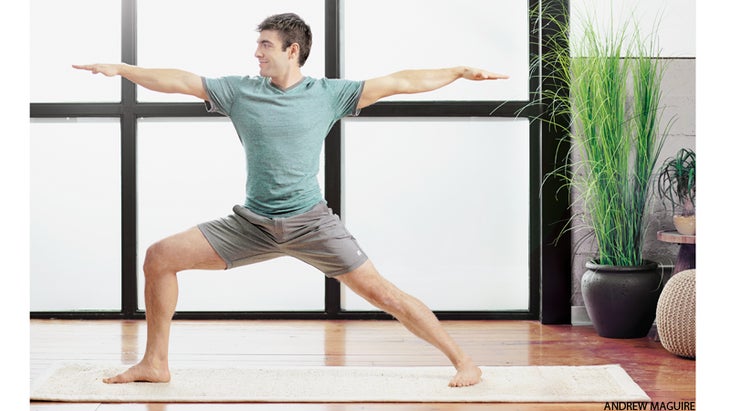
6. Warrior 2 (Virabhadrasana II)
Stand facing the long side of the mat with your feet wider than hip-distance apart. Press your feet into the floor and draw your navel toward your spine. Turn your right foot toward the top of the mat. Turn your left foot in slightly. Press your feet into the mat, inhale and reach your arms straight out to the sides while keeping your chest facing the long side of the mat. Exhale and bend your right knee. Straighten your back leg and press through the outer edge of your foot to lift your arch. Take 5 breaths here.
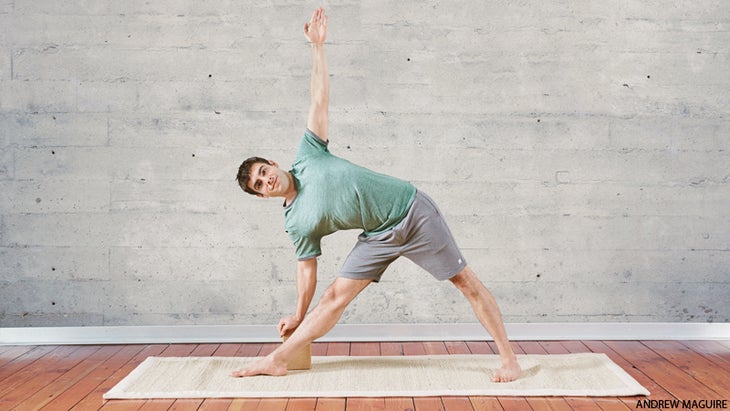
7. Extended Triangle Pose (Utthita Trikonasana)
From Warrior 2, draw your awareness from your feet all the way through to the top of your head. Straighten your front leg, lean your right side forward over your front leg, and place your right hand on a block or your shin. Draw your navel toward your spine. Reach your left arm toward the ceiling in Extended Triangle Pose. Take 5 breaths here, doing your best to maintain Ujjayi breath. To come out of it, inhale and press your feet into the floor. Exhale and rise to standing. Repeat Warrior 2 and Triangle on the other side.
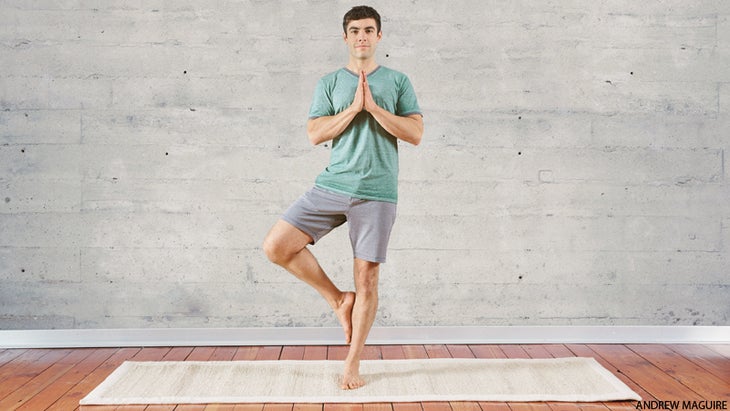
8. Tree Pose (Vrksasana)
Keep your gaze, or drishti, fixed on one point in front of you to steady yourself. Press both feet firmly into the floor and draw your awareness to the crown of your head as you draw your navel toward your spine. Lift your right foot and place it above or below your left knee. Press your foot into your leg and press your leg into your foot. Place your hands on your hips or press your palms together at your chest in prayer position (anjali mudra). Stay here or reach your arms toward the ceiling as if they are limbs on a tree growing toward the sun. Stay calm and steady by focusing on your drishti and your breath, even if your tree sways a little. Take 5-10 breaths. Then lower your leg back to standing. Repeat on the other side.
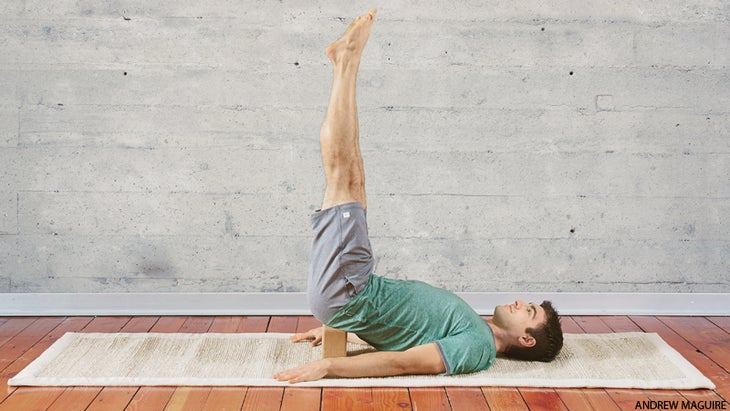
9. Supported Shoulderstand Variation (Salamba Sarvangasana)
Lie on your back with your feet on the floor hip-distance apart. Inhale and press your feet into the floor as you lift your hips. Place a block under your sacrum—the triangular bone at the base of your spine—on the lowest or medium height, whatever feels comfortable. Place your hands alongside your body and press firmly into the floor. Draw your chin toward your chest (do not turn your head from side to side). Exhale and draw your right knee toward your chest. Inhale and extend your right leg toward the ceiling. Take 3-5 breaths here. Exhale and draw your right knee back to your chest. Inhale and step your right foot back to the floor. Exhale and draw your left knee toward your chest. Inhale and extend your left leg toward the ceiling. Take 3-5 breaths here. Exhale and draw your left knee back to your chest. Draw your right knee to your chest to meet the left. Keep pressing your hands into the floor to help you balance. Inhale and extend both legs toward the ceiling. Stay here for up to 5 breaths. To come out of it, exhale and draw both knees into your chest. Inhale and place both feet back on the floor. Remove the block by pressing your feet into the floor to lift your hips. Slowly lower back to the floor. Take a moment here to let your spine settle.
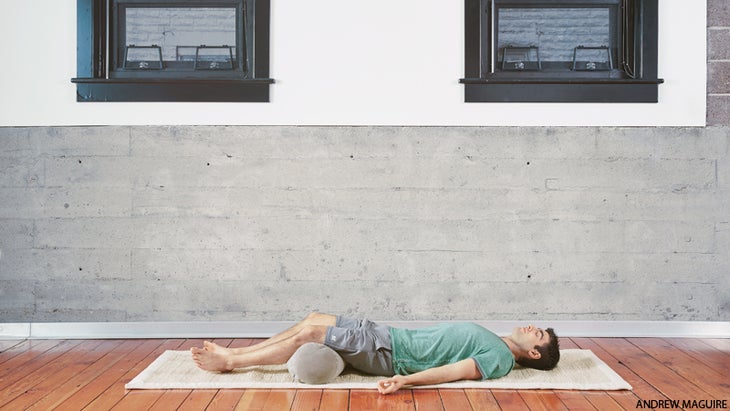
10. Corpse Pose (Savasana)
Lie on your back with your legs and arms relaxed and your palms facing up. You can place pillows or a rolled blanket under your knees to reduce tension in your lower back. If Savasana isn’t comfortable, even with props, find a posture you can relax in. Close your eyes or soften them. Spend 5-10 minutes here, allowing your body and mind to absorb the work that you’ve done.
This article has been updated. Originally published February 3, 2016.